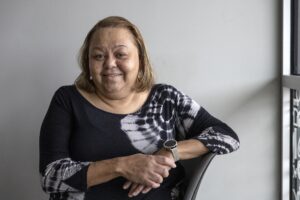The Upstream Imperative, Volume 2
This article is part of “The Upstream Imperative,” a series exploring the challenges and opportunities facing the social services sector.
By Adair Mosley, President and CEO, Pillsbury United Communities
If you’re like me, you want to solve the stubborn disparities that exist in our community. It can be daunting to talk about, and there are no easy answers. But I believe the change we want is possible if we are willing to zoom out. Only by tackling the root causes that brought us to this place can we get past them as a society.
This is what I mean by the Upstream Imperative: elevating our strategy to engage the systems — not merely the symptoms — that hold back people’s lives across generations.
Facing the factors
Nowhere is this upstream response more needed than in population health. We know that the health of our community is shaped to the greatest extent by social determinants: factors including neighborhood livability, housing, education, and economic prosperity. These factors influence people’s lifelong wellbeing more than any hospital, doctor, or medication.
Why does Minnesota have some of the largest racial disparities in the nation? Because life in black and brown communities has long been adversely impacted by systemic racism and inequity. This context affects everything: people’s access to nutritious food and health education, their exposure to environmental hazards, and their likelihood of living in substandard housing. It imposes extra costs and barriers when they access healthcare and produces toxic stress that puts people at risk for lifelong health problems.
If we’re serious about closing these gaps, we need to think at the scale of this systemic challenge. That means bringing all stakeholders to the table to innovate with an inclusive approach.
Assessing root causes
We can’t solve problems we don’t clearly understand. Which is why the Affordable Care Act mandated that non-profit health systems conduct health assessments in the communities they serve. Such assessments can unite payers, providers, and policymakers around the same goal — be it care access, nutrition, housing, education, or all of the above — and guide a coordinated response.
Without a mandate to address social needs and root causes, the efforts of health systems to date have been largely reactive and disconnected from the people they’re meant to help. As that mandate changes, organizations like Pillsbury United have an essential role to play. As a connector between healthcare systems and our communities, we can help produce a truer picture of life and health in our neighborhoods — the first step in creating an effective response based on the community’s real needs and assets.
Human connections
Foremost among these assets are people. In communities of color, there have always been navigators — people who deeply understand their neighbors’ perspective and help them navigate their critical social needs, from health care to housing. The role they play is usually hidden and seldom compensated, but their impact is no less important than that of doctors. They guide people to overcome cultural and economic barriers to better health in ways the traditional healthcare model cannot.
That’s an opportunity. By investing in the capacity of these navigators and elevating their role as true Community Health Workers, we can empower our communities’ human resources to do even more. They deserve better tools and support and to have a voice in matters than affect their families and neighbors. Despite proof that such a model works, it is not as well funded as it should be. Policymakers, payers, and healthcare systems can help change that.
Convener and conduit
Health has been at the center of our work for over 140 years. Supporting whole people in whole communities is part of our Settlement House roots. We understand the importance of working in, for, and with community, listening to people most affected and giving them tools to create solutions relevant to their lives.
As healthcare systems begin to embrace more encompassing, community-based solutions, agencies like Pillsbury United are poised to make them successful. As intentional partners, we can ensure an intersecting regional response big enough to create historic change aligned with the goals of stakeholders and needs on the ground.
We envision a future where people achieve greater personal health and wellbeing together. For the communities we serve, this future can’t wait.



